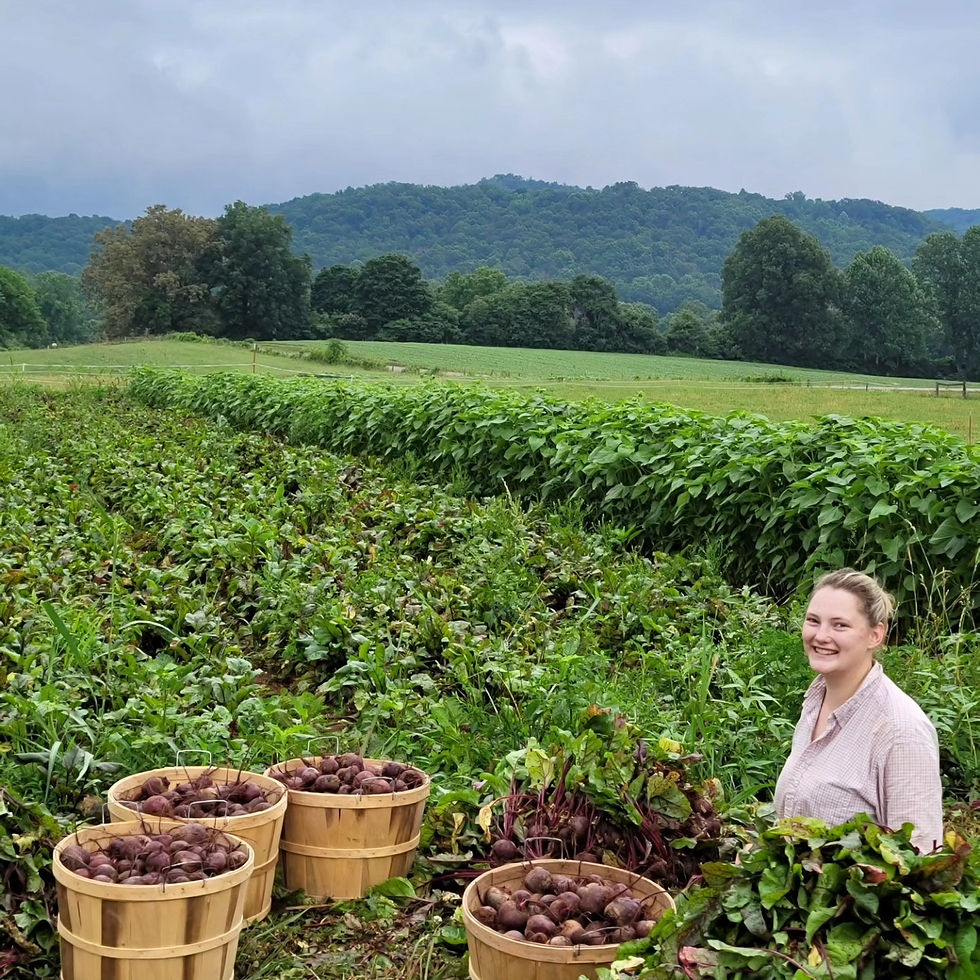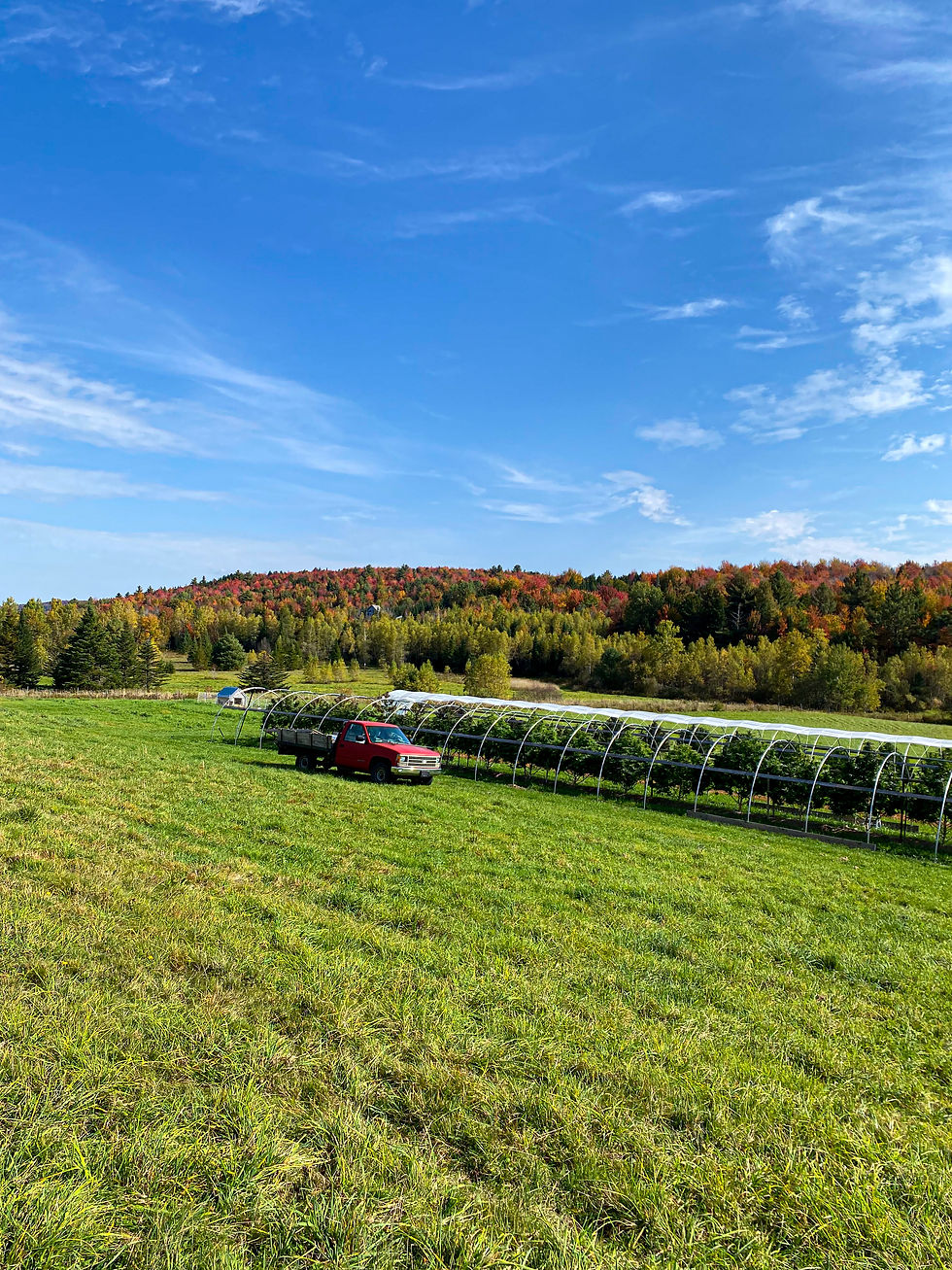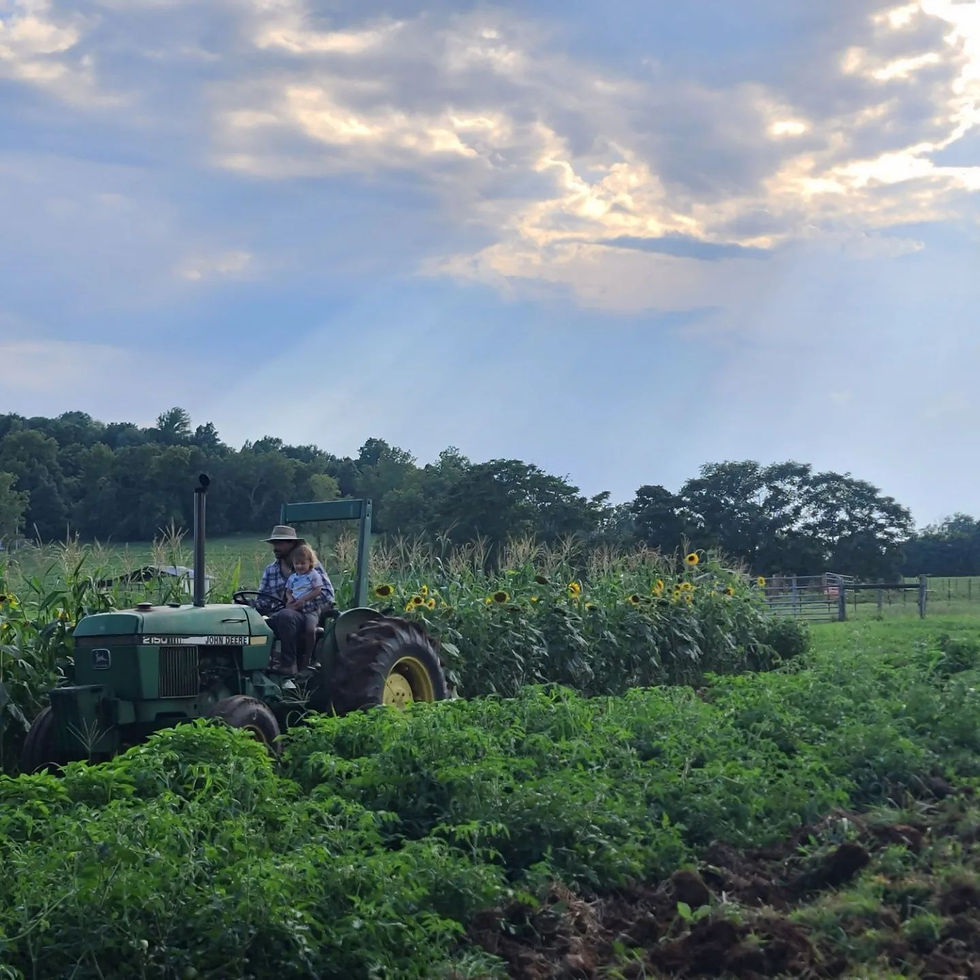Let Us Gather on the Land
- Darby Weaver

- Oct 9, 2024
- 8 min read
Updated: Dec 21, 2024
Narration by Kristina Villa
Grief in My Pocket
Early October in Northern Vermont is some kind of magic. Our small farm is situated on a hillside in a rolling valley on top of a ridge, and the green fields sprawl playfully toward mountain hillsides alight with the reds, oranges, and yellows of fall’s great show. I have been walking around in the golden light feeling as though I live inside a miracle. These crisp autumn days in the plants are something I look forward to and cherish every season. Even so, as my eyes and heart are overwhelmed by the natural beauty, my phone pings tirelessly in my pocket with dark news.
My phone pings tirelessly in my pocket with dark news.
My joy for this beautiful season on the farm is slowly eaten away by insidious feelings of survivor’s guilt as I learn more about the absolute devastation in Southern Appalachia. My husband and I have been farming for the last 15 years, and there was a time when we were deciding between moving our farm to Vermont or Asheville, North Carolina. When discussing the pros and cons of both locations, it hadn’t crossed our minds that either of these beautiful, landlocked, mountainous regions could be ravaged by catastrophic storms that would have lasting impacts for years to come.

The storm that cut us off from civilization and destroyed farms, homes, and businesses across Vermont on July 11, 2023 and Hurricane Helene’s 500-mile path of destruction are symptoms of the fragmentation of our natural world and the continued distancing of our industries and culture from the land. The destabilizing of our climate is a burden we will all carry and events around the globe are revealing to us that it isn’t simply the rising sea levels we need to worry about. Small rural towns in beatific locations across North America have seen an increase in out-of-state interest as individuals consider options for what a difficult future may look like. These same places of climate refuge now battle unprecedented floods, wind, droughts, arctic blasts, and wildfires, and our collective grief over this new uncertainty grows.
Hope is a seed and it is planted in the heart of every individual called to steward the land.
Doom-scrolling the internet for even five minutes can leave you feeling powerless against the momentum of it all. And yet, as I study the brown lacewing larvae scarfing up aphids on my plants and thank the traveling turkeys for taking a tour of my lower pasture, I am reminded that hope is a seed and it is planted in the heart of every individual called to steward the land.
Farmers Tend Hope
Farmers are often overlooked members of our modern society. They rarely chase fame or TikTok views and are portrayed by modern media to be simple people with a lack of interest in adventure or culture. What the majority doesn’t realize, is that farmers are keepers of great wisdom and their skillful work and the land they tend are our greatest hope for a prosperous, green, and just future for all.
At The Farmers Land Trust, we acknowledge and prioritize this significant role held by dedicated land stewards in our culture. Regenerative farmers are the bridge between the human world and the natural world and their efforts on the land show us how we may integrate our lives and needs back into the natural cycles that keep our planet and people well. We believe that preserving farmland in active farming is essential and it is our mission to support the individuals and communities that are tying us back to the land.

You’ve likely heard the troubling statistic that the average age of farmers in the United States is rising. The average age of farmers cited in the 2022 USDA Agriculture Census was 58.1 years old, continuing a long-term trend. Additionally, the survey noted that every year since 1935, the United States has been losing farmland. From 6.8 million farms counted in the 1935 census, the USDA counted just two million farms in their 2022 survey. This loss can be attributed to many factors, including two major contributors: farm consolidation and development.
According to American Farmland Trust, the United States is losing 2,000 acres of farmland a day to low-density, residential sprawl. As available farmland dwindles, market-driven land values continue to grow. In the Land Values 2023 Summary issued by the National Agricultural Statistics Service of the USDA, the average cost of farmland in the United States jumped to $4,080 per acre this year, up 7.4 percent since 2022.
The United States is losing 2,000 acres of farmland a day.
What does this all mean? It means that the United States farmland is dwindling and active farms are being consolidated. It means that we are leaning on our elder farmers to carry the burden of our food system as they reach retirement age. It means that elders are selling off their farmland as their biggest asset to survive in their later years and young farmers are unable to afford to buy it. It is this crossroads, where commercial real estate has created a disconnection between our elders on the land and the new and beginning farmers who wish to carry forward their legacy, that is unraveling our food system and further fragmenting our natural world in the United States today.
The Farmland Commons
Here at The Farmers Land Trust, we are dedicated to bridging this gap. We are a national nonprofit that engages directly with farmland protection and land access and tenure for farmers. Through the facilitation of farmland transitions from one generation to the next and through the development of the Farmland Commons, we are working to preserve the land legacy of organic, regenerative, and biodynamic farms. Expanding on the concept of the Community-Supported Agriculture (CSA) programs of farms across the country, the Farmland Commons model provides a structure for communities to further support the farms that feed them through the establishment of nonprofit land-holding entities that are local and secure tenure for present-day farmers and future generations.

While most land trust organizations are focused on protecting natural habitats from the disturbance of development and industry, we are dedicated to protecting working farms and preserving their productivity and ecological contributions to the land. Most land trust organizations utilize conservation easements that limit land rights and uses and are made up of restrictions for land use that can restrict the activities of a productive farm.
While most land trust organizations are focused on protecting natural habitats from the disturbance of development and industry, we are dedicated to protecting working farms and preserving their productivity and ecological contributions to the land.
At The Farmers Land Trust, we are prioritizing the protection of regenerative farms through securing the land for farmers with stipulations for land use that promote ecological stewardship. Through the Farmland Commons model, the land is decommodified in perpetuity and placed in nonprofit ownership of the local communities who are nourished by it. It is accomplished by expanding on the CSA farm business model to think about land ownership, land equity, and land tenure as functions of community.
How to Create Community-Held Land
The Farmland Commons are created by forming a land-holding entity through the establishment of an IRS-designated 501(c)(25) nonprofit, which is formed when three to 35 501(c)(3) nonprofits work together on a shared goal. Once the partner organizations come together to protect agricultural land, a board is created for the 501(c)(25) that is made up of members of the parent 501(c)(3) organizations.

These nonprofits can be national, regional, or local, but a focus is put on organizations that have community roots. Having a mix of local and national representation can bring great benefit to the network by extending support and resources to the larger capacity held at organizations on the national level. The 501(c)(25) itself is a limited-scope entity that exists exclusively to hold title to acquired real estate and convey the lease of this real estate to the farm business.
The assembled board that represents the parent nonprofits determines the terms of the lease. The Farmers Land Trust advocates for affordability and equity through the establishment of a 99-year lease agreement. The board of the 501(c)(25) can harness its legal position to take in lease revenue and pursue tax-deductible, philanthropic funding acquired through the connections and partnerships held by the 501(c)(3) parent organizations.
This means that the next generation of farmers (these farmers can be organized into any legal structure; such as an individual, LLC, or nonprofit) gets a 99-year lease on the land, giving them all rights to use the land and long-term, affordable tenure to that land. The board seat held by the farmer means that they are not only leaseholders to the land, but also have ownership in the structure itself. Additionally, as leaseholders of the community-held land, they can be owners of buildings and other infrastructure on the land, giving them a way to build equity.

The 501(c)(25) manages the real estate, holding responsibilities of taxes, insurance, permits, approvals, and capital improvements. The 501(c)(25) creates and manages an ongoing budget designed to reinvest in the agricultural infrastructure and cover all current and future carrying costs of the agricultural real estate. It also covers any other costs associated with the related management efforts made by the member nonprofits.
The Farmland Commons model protects farmland and secures tenure for farmers by removing it from the commercial real estate market. It gives communities a deeper connection and commitment to the land that feeds them. It allows farmers to focus on the essential work of growing food and stewarding land while also giving them the most agency for decision-making and control of their farms. It is a different path forward that empowers farmers and communities. It is a path that brings the power back to the people and the land, and slows the commercial unraveling of our farmland and habitats.
We’re in This Together
In many ways it feels like the experience in the United States for the last 400 years—our use of resources, our systemic oppression, our insatiable materialism and rugged individualism, has been an elite party that has very abruptly come to an end. The difficult realities and impacts of capitalism we are facing today with our farmland, and housing crisis, and inflation among others, combined with the ever-increasing occurrence of natural disasters, are all pointing to a need to come together, to re-root lifestyles into the land, and to find our way back to community.

The aftermath of Hurricane Helene has been documented in horrific pictures and stories and the trauma has sent shockwaves into our world that can be felt by us all. Simultaneously, the interviews of people on the ground and the messages shared by the survivors have been messages of love, rebuilding, togetherness, and hope.
When terrible things happen and we are brought to our knees, we are reminded of what is truly important. We are reminded that we are at our strongest when we come together. It is our hope at The Farmers Land Trust that we can use the preservation of America’s farmland as our gathering place.
It is our hope that we can build the framework for a robust society, nested into the ecology and nourishment of the landscape, and strengthened by our re-dedication to caring for each other and the natural world.

We have the opportunity to do this work now. Every farm saved and preserved in active farming is a piece of the unraveling halted. Community-held land is the foundation for community strength and resilience for whatever the future may bring. Will you join us?



Commentaires